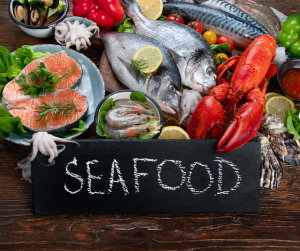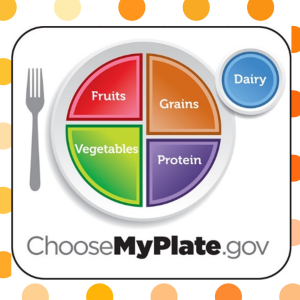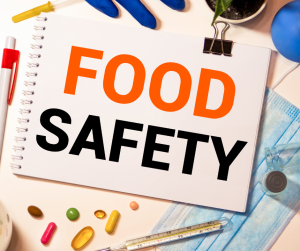Introduction
I try to eat fish several times during the week. Many organizations have recommended eating seafood twice a week. For example, the US Dietary Guidelines for Americans recommends that adults eat eight ounces of fish or seafood per week. https://www.dietaryguidelines.gov/sites/default/files/2021-03/DGA_2020-2025_StartSimple_withMyPlate_English_color.pdf Seafood includes fish and shellfish, such as salmon, clams, oysters, tuna, snapper, shrimp, crab, and lobster. You can buy it fresh, frozen, and/or canned. Seafood can be expensive and purchasing it may make a dent in your budget. Canned seafood may be less expensive. Fresh fish and shellfish are perishable, and we need to keep food safety in mind when purchasing, handling, and cooking it. Seafood can be a part of a well-balanced and nutritious diet.

Nutrition and Health
On the MyPlate graphic, seafood is found in the protein group, which is shown in purple. Seafood can be a lean protein choice that contains vitamins, minerals, and omega-3 fatty acids. Omega-3 fatty acids may play a part in reducing the risk of heart disease. https://www.myplate.gov/eat-healthy/protein-foods Eating 8 ounces per week of seafood may help reduce the risk of heart disease. Individuals with allergies to fish or shellfish must read food labels carefully and not eat any foods they are allergic to. Healthy individuals may choose to eat raw or partially cooked seafood, but young children, immunocompromised individuals, pregnant or nursing females, and older adults should avoid eating raw seafood. Seafood can add a variety of flavors, textures, protein, and appeal to your weekly menu.

Purchasing and Other Considerations
It can be tricky when buying seafood, and individuals need to be careful. Consider food safety when purchasing and preparing fish and seafood.
- When in the grocery store, place seafood in a plastic bag, before you put it into your grocery cart so that juices don’t drip onto other products. By doing this, it prevents cross-contamination.
- Check the purchase by date and/or expiration date. Read the label. You may want to see how and where it was caught and/or raised. https://blogs.ifas.ufl.edu/browardco/2023/11/01/food-labeling/
- The fishy smell turns some people off. Smell it. What does it smell like? Don’t purchase fish with a strong fishy-type odor. Look at it. What color is it? Is there discoloration?
- The visible appearance of ice crystals may be a sign that the product is old and/or has warmed up and then been refrozen during the transportation process.
- Go directly home after you have loaded the groceries into your vehicle. Don’t make several other stops for errands on the way home, after purchasing perishable food such as seafood.
- Immediately put seafood into the cold refrigerator to maintain the temperature at 40 degrees Fahrenheit or below, or in the freezer below 0 degrees Fahrenheit.
- Keep raw and cooked seafood separate from other items in your refrigerator. Prevent cross-contamination.
- Wash your hands for at least 20 seconds before and after preparing seafood in your kitchen. https://blogs.ifas.ufl.edu/browardco/2024/01/25/handwashing-is-critical-to-good-health/
- Never serve cooked fish or seafood on a plate or platter that previously held the raw product, without proper cleaning of the plate first.
- Clean and sanitize any surfaces or utensils that have come into contact with fish or seafood.
- Summary: Keep it cold. Keep it clean. Store it quickly. Prepare and cook it properly. https://www.seafoodhealthfacts.org/safety/seafood-handling-and-storage/

Cooking
There are different ways of cooking fish and seafood. Baked, broiled, grilled, fried, and steamed are a few. Although fried fish is delicious it may not be the healthiest way to cook fish, if you are trying to control your fat and calorie intake. By choosing fried, you are consuming extra fat and calories which may not be beneficial to heart health or body weight. Pan-fried (cooking method) uses less oil(s) than deep-fried but still needs to be eaten in moderation.
Remember the recommendations for food safety: CLEAN, COOK, SEPARATE, and CHILL. https://blogs.ifas.ufl.edu/browardco/2022/02/08/engaging-in-food-safety-behaviors-does-matter/ Pathogens and bacteria may be present in fish and seafood. Cook seafood to an internal temperature of 145 degrees Fahrenheit for 15 seconds until the flesh is opaque and flaky. For specific recommendations on cooking guidelines for different seafood products, go to a reputable website with tested and vetted recipes. Use a food thermometer to test the internal temperature in the thickest part to make sure that food is properly cooked. https://www.fightbac.org/food-safety-basics/the-core-four-practices/#:~:text=Cook%20fish%20to%20145%20%C2%B0F%20or%20until%20the,is%20opaque%20and%20separates%20easily%20with%20a%20fork.
Store leftovers, properly wrapped in the refrigerator within 2 hours. https://blogs.ifas.ufl.edu/browardco/2023/10/02/food-safety-the-2-hour-rule/ Bacteria will grow rapidly in the danger zone of 40 to 140 degrees Fahrenheit. Keep hot foods hot and cold foods cold. Foodborne illness risk is serious, and these tips should be considered when handling and cooking these items to keep your food safe to eat.

Eating
Will you be eating any fish or seafood this week? Looking for some recipe ideas? https://www.followfreshfromflorida.com/recipes I will be eating broiled salmon with seasoned rice and fresh green beans. Enjoy properly handled and cooked seafood as a healthy part of a well-balanced diet.
Read more to learn more:
UF/IFAS Extension, Broward County, Be Aware of the Risks of Eating Raw Oysters – https://blogs.ifas.ufl.edu/browardco/2022/08/26/eating-raw-oysters/
UF/IFAS Extension, Broward County, Take Care of Your Heart – https://blogs.ifas.ufl.edu/browardco/2023/02/01/take-care-of-your-heart/
US Dietary Guidelines for Americans 2020-2025/ 10 things to know – https://www.dietaryguidelines.gov/2020-2025-dietary-guidelines-online-materials/top-10-things-you-need-know
Follow the rainbow for good health – https://blogs.ifas.ufl.edu/browardco/2022/03/01/follow-the-rainbow-for-good-health-during-nutrition-month/
Seafood health facts – http://seafoodhealthfacts.org/
Seafood recipes – https://www.followfreshfromflorida.com/recipes
Seafood safety – http://seafoodhealthfacts.org/pdf/seafood-safety-pc-handling.pdf
MyPlate/Protein Foods – https://www.myplate.gov/eat-healthy/protein-foods
FDA and Seafood Safety – https://www.fda.gov/food/resources-you-food/seafood
An equal opportunity institution.
 5
5
